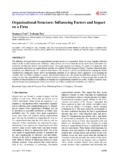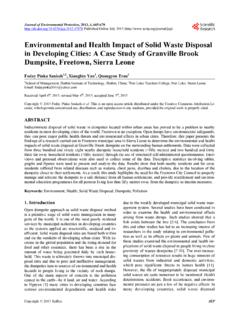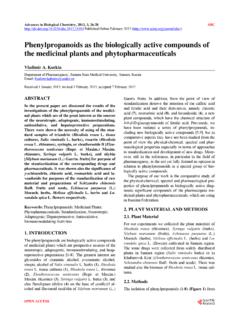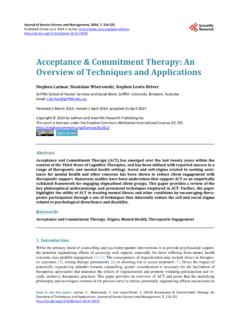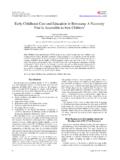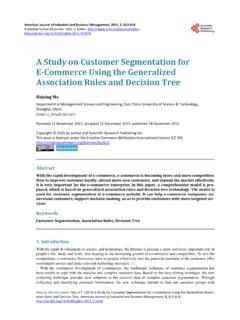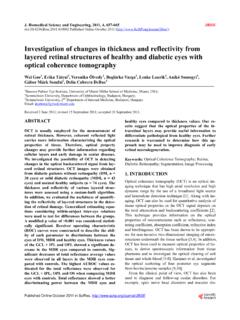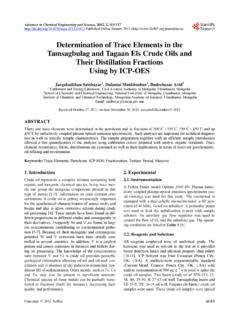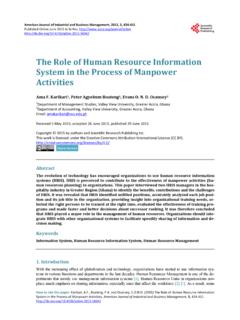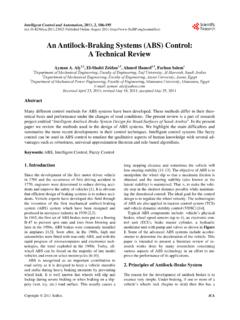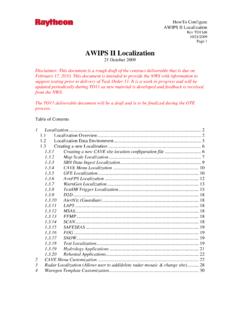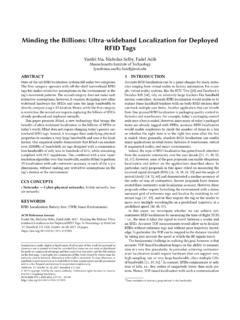Transcription of RSSI-based Algorithm for Indoor Localization
1 Communications and Network, 2013, 5, 37-42 Published Online May 2013 ( ) RSSI-based Algorithm for Indoor Localization Xiuyan Zhu, Yuan Feng* College of Information Science and Engineering, Ocean University of China, Qingdao, China Email: Received 2013 ABSTRACT Wireless node Localization is one of the key technologies for wireless sensor networks. Outdoor Localization can use GPS, AGPS (Assisted Global Positioning System) [6], but in buildings like supermarkets and underground parking, the accuracy of GPS and even AGPS will be greatly reduced. Since Indoor Localization requests higher accuracy, using GPS or AGPS for Indoor Localization is not feasible in the current view.
2 RSSI-based trilateral Localization Algorithm , due to its low cost, no additional hardware support, and easy-understanding, it becomes the mainstream Localization Algorithm in wireless sensor networks. With the development of wireless sensor networks and smart devices, the num-ber of WIFI access point in these buildings is increasing, as long as a mobile smart device can detect three or three more known WIFI hotspots positions, it would be relatively easy to realize self- Localization (Usually WIFI access points locations are fixed). The key problem is that the RSSI value is relatively vulnerable to the influence of the physical en-vironment, causing large calculation error in RSSI-based Localization Algorithm .
3 The paper proposes an improved RSSI-based Algorithm , the experimental results show that compared with original RSSI-based Localization algorithms the Algorithm improves the Localization accuracy and reduces the deviation. Keywords: Indoor Localization Algorithm ; RSSI-based ; WIFI Access Point; Smart Phones 1. Introduction More than 80% information is related to spatial location, and modern people spend about 80% - 90% time of their whole life indoors. Now along with the popularization of information and communication technology, people s demands for Indoor location information are growing.
4 In some public places, such as shopping malls, airports, exhibition halls, office buildings, warehouses, under- ground parking, prisons, military training bases, people need precise location information. Precise Indoor loca- tion information can be used to achieve efficient man- agement of the available space and inventory substances; can help police, firefighters, soldiers, medical staff to complete specific tasks; smart spaces and pervasive computing are also inseparable from the location- based services. So currently, Indoor Localization is a hot re- search with broad application prospects [9].
5 Compared with outdoor Localization , the difficulty of Indoor Localization lies in that Indoor maps pay more attention to small areas, large-scale, high precision and subtly display of the internal elements [7]. Along with the rapid development of wireless net- works and smart phones, the number of WIFI access points increase dramatically and most WIFI access points locations are fixed. This phenomenon suggests a new direction for Indoor Localization research in wireless sensor network. Existing wireless Localization algorithms require either special hardware support or complex computing, which consuming valuable battery resources greatly, especially comes to smart phones or sensors.
6 The contribution of this paper is that it proposed a new Algorithm which increase the Indoor Localization accuracy without any additional hardware support or increasing the computa- tional complexity. 2. Related Work Indoor Localization Technologies There are many wireless Localization technologies and solutions. The commonly used Localization techniques include infrared, ultrasonic, radio frequency signal, Blue- tooth, and Ultra-Wideband, WIFI, etc.[8], but they are not suitable for Indoor Localization . Infrared is only suit-able for short-distance transmission, and could easily be influenced by fluorescent lamp or the light in the room, there are limitations on the Localization accuracy; ultra-sonic, Bluetooth and Ultra-Wideband require special equipment, the cost is too high, hence they are not widely used; RF signal does not have communication capability, and is not easy to be integrated into other systems.
7 At present, more and more Indoor WIFI access points *Corresponding author. Copyright 2013 SciRes. CN X. Y. ZHU, Y. Feng 38 are open and free. The most widely used Localization technology is using WIFI. Localization Algorithms Wireless Localization algorithms can be roughly divided into two categories[2], Range- based and Range-free lo-calization algorithms. Range- based Localization algorithms mainly include RSSI-based trilateral Localization Algorithm , arrival angle Algorithm (AOA), arrival time Algorithm (TOA) and time difference of arrival (TDOA) Algorithm .
8 TOA requires precise clock synchronization; TDOA node is equipped with ultrasonic transmitters and receivers; AOA needs antenna array or microphone arrays. These three algo-rithms Localization accuracy is high, however with high hardware requirements. Range-free Localization Algorithm mainly includes centroid Algorithm , DV-hop Algorithm , MDS-MAP algo-rithm and convex programming. Range-free algorithms mainly use the geometric relationship between neighbor-ing nodes to estimate Localization . They have low hard-ware requirements, but the Localization accuracy is too low for Indoor environment.
9 Because of its simple, easy-understanding and low cost, RSSI-based trilateral Localization Algorithm has a wide range of applications. 3. Trilateral Localization Algorithm Wireless Signal Propagation Loss Models In this paper we use the mainstream logarithmic distance path loss model, , log model. The propagation model points out that whether in Indoor or outdoor channel, the average received signal power decreases with the loga-rithm of distance. This model has been widely used. For any T-R distance, the path loss is expressed as: 01, 2,..,iidLdPid n (1) or 010010log(1, 2.)
10 , )idPL dBPL dind (2) In the above formula, 0 represents near earth refer-ence distance, d 0PL d is the signal strength at distance 0 and d is the signal attenuation factor and its value is between 2 to 6 in different environments. Trilateral Localization Assume there are n anchor nodes, and the location of the unknown node is (, )xy, 'i is the estimated distance between the unknown node and the anchor node dith (, )iixy obtained by using the log-model and repre-sents the real distance. Then id'2200()( )(1,2,..iiidxxyyi )n (3) The difference between the real distance and the esti-mated distance is expressed as 'iiidd.
